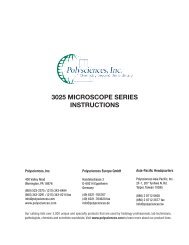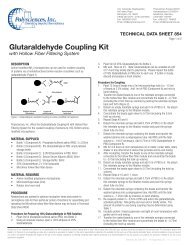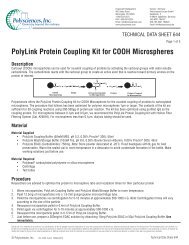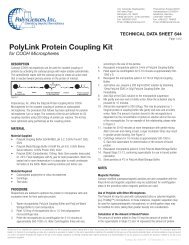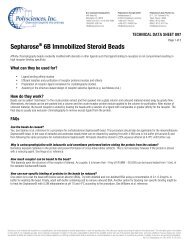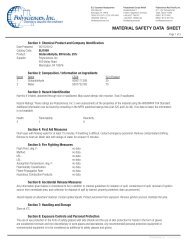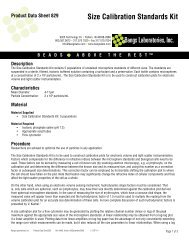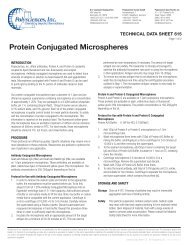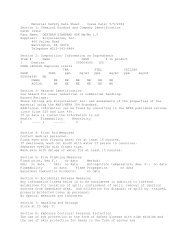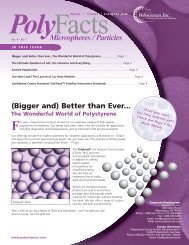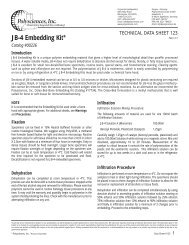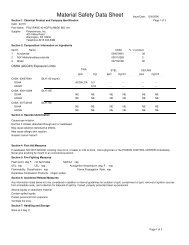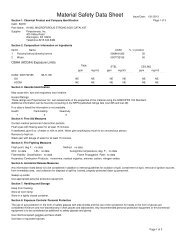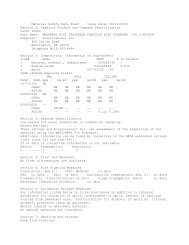Data Sheet #305A: LR White Resin and ... - Polysciences, Inc.
Data Sheet #305A: LR White Resin and ... - Polysciences, Inc.
Data Sheet #305A: LR White Resin and ... - Polysciences, Inc.
Create successful ePaper yourself
Turn your PDF publications into a flip-book with our unique Google optimized e-Paper software.
Infiltration:<br />
L.R. <strong>White</strong> has an extremely low viscosity, enabling shorter<br />
infiltration times in the resin. Perform infiltration with<br />
resin only. Infiltration times will depend on the tissue size<br />
<strong>and</strong> density.<br />
1. L.R. <strong>White</strong> <strong>Resin</strong> (Only) 2 changes 1 hour each (Minimum)<br />
2. L.R. <strong>White</strong> <strong>Resin</strong> (Only) 1 change 1 hour or overnight<br />
Use a gentle rocker table or wheel to assure proper infiltration<br />
for all tissues.<br />
Embedding:<br />
Room Temperature Curing<br />
Room temperature curing may give slightly better cutting<br />
properties for LM while thermal curing is better for EM<br />
examination.<br />
The embedding solution is made by adding 20µl (with a calibrated<br />
micropipette <strong>and</strong> tip*) of L.R. <strong>White</strong> Accelerator to<br />
10ml of L.R. <strong>White</strong> resin just prior to use <strong>and</strong> mixing well.<br />
* Using a calibrated micropipette <strong>and</strong> tip is the only<br />
accurate way to measure 20µl. Using a disposable or<br />
non-calibrated pipette to estimate one drop or 20µl<br />
can result in the addition of too much accelerator.<br />
This will cause the exothermic reaction to occur too<br />
quickly resulting in bubbling <strong>and</strong> over-heating of the<br />
specimen. Exact measurement of 20µl will produce<br />
consistent blocks every time.<br />
L.R. <strong>White</strong> <strong>Resin</strong> with added accelerator should polymerize<br />
in 10 to 20 minutes at room temperature. The addition<br />
of too much accelerator will cause the resin to polymerize<br />
faster. It is not necessary to exclude air for room temperature<br />
polymerization. The exothermic reaction during<br />
polymerization causes the generation of heat. The blocks<br />
should be cooled to room temperature prior to removal<br />
from the molds.<br />
To reduce the exothermic reaction, L.R. <strong>White</strong> can be<br />
polymerized at 0°C to 4°C. Capping the BEEM ® capsules<br />
<strong>and</strong> using block holders is advised for cold polymerization<br />
to prevent contact with water <strong>and</strong> to assist with the polymerization<br />
process.<br />
For larger specimens, place the molds in an ice bath or<br />
quickly fill <strong>and</strong> move to a 4°C refrigerator for several hours<br />
to overnight. Cold polymerization occurs in 45 minutes to<br />
1 hour for BEEM ® capsules on ice. Larger molds may<br />
require several hours for cold polymerization. In this case,<br />
refrigeration is the best method. The polymerization will<br />
layer from the bottom up. Do not check the progress of<br />
the polymerization by lifting the capsule or block holder.<br />
Thermal Curing<br />
TECHNICAL DATA SHEET 305A<br />
Thermal curing with L.R. <strong>White</strong> requires no mixing of components.<br />
Use L.R. <strong>White</strong> <strong>Resin</strong> directly from the bottle to<br />
fill JB-4 molds or BEEM ® capsules either before or after<br />
the tissue has been oriented in the correct plane. The<br />
BEEM ® capsules must be capped <strong>and</strong> the JB-4 molds<br />
must have block holders in place to exclude oxygen,<br />
which will prevent complete polymerization. Place filled<br />
molds in a 60°C to 65°C oven for 12 to 20 hours for polymerization.<br />
Cool the blocks to room temperature prior to<br />
removal from the molds.<br />
Storage of <strong>LR</strong> <strong>White</strong> <strong>Resin</strong> <strong>and</strong> Accelerator:<br />
L.R. <strong>White</strong> should be kept at 4°C. Only the amount<br />
required should be removed from the bottle <strong>and</strong> allowed<br />
to come to room temperature. The cap should be replaced<br />
immediately <strong>and</strong> kept tight at all times to reduce oxygen in<br />
the solution <strong>and</strong> the absorption of water from humidity <strong>and</strong><br />
condensation. The addition of oxygen or water can inhibit<br />
polymerization during embedding. The accelerator can be<br />
stored in a cool dark area at room temperature.<br />
Sectioning <strong>and</strong> Mounting<br />
Page 2 of 3<br />
L.R. <strong>White</strong> will require a microtome that is designed to<br />
section plastics. Routine paraffin microtomes are not<br />
appropriate for plastics, as they cause chatter in the sections.<br />
Replace glass knives with tungsten carbide triangular<br />
knives for small blocks. Larger blocks require either<br />
the larger tungsten carbide blades or glass Ralph knives.<br />
Section smaller block faces as thin as 0.25µ with either<br />
knife type. Section larger blocks at 1.0µ to 5µ with tungsten<br />
carbide blades. Thicker sections may be more difficult<br />
to produce due to chatter or shattering of the material.<br />
Use a drop of water to help exp<strong>and</strong> the plastic for mounting<br />
on glass slides. An applicator stick soaked in acetone<br />
gently waved over the section <strong>and</strong> water will further<br />
exp<strong>and</strong> the section. Place the slide on a hot plate at 60°C<br />
to 70°C to evaporate the water <strong>and</strong> adhere the section to<br />
the slide. Use a solution of 30% to 40% acetone <strong>and</strong><br />
water to float the sections followed by air drying prior to<br />
placement on the hot plate. DO NOT USE ACETONE ON<br />
THE HOT PLATE.<br />
Should any of our materials fail to perform to our specifications, we will be pleased to provide replacements or return the purchase price. We solicit your inquiries concerning all needs for life sciences work. The<br />
information given in this bulletin is to the best of our knowledge accurate, but no warranty is expressed or implied. It is the user’s responsibility to determine the suitability for his own use of the products described<br />
herein, <strong>and</strong> since conditions of use are beyond our control, we disclaim all liability with respect to the use of any material supplied by us. Nothing contained herein shall be construed as a recommendation to use<br />
any product or to practice any process in violation of any law or any government regulation.<br />
© <strong>Polysciences</strong>, <strong>Inc</strong>. 1204RevB <strong>Data</strong> <strong>Sheet</strong> <strong>#305A</strong> 1



